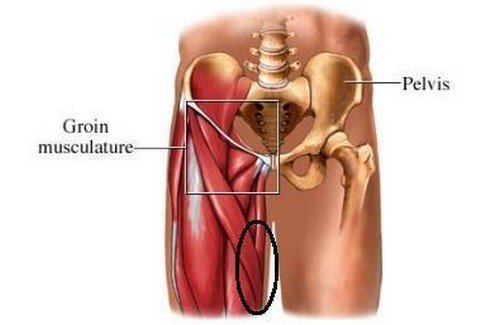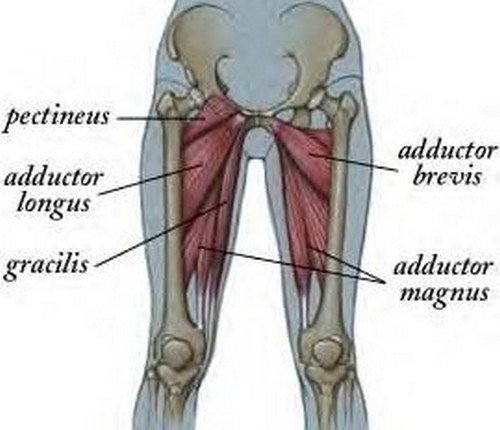Inner Thigh Pain
Inner thigh pain causes discomfort on the thigh area and the side of the legs, specifically in the groin area, upper inner thigh, and knee. The pain is intense and usually the patients describe the pain as dull, stabbing, and sharp.
During severe pain attacks, the pain is felt in the rest of the body, which makes it hard for a person to move. There are various reasons why a person experiences inner thigh pain. They will be discussed further below. (1, 2)

Image 1: A closer look at the inner thigh muscles.
Picture Source: forums.t-nation.com

Picture 2: The different muscles of the thigh.
Photo Source: images.elephantjournal.com

Photo 3: Kidney stones, one of the reasons for inner thigh pain.
Picture Source: naturalremedyideas.com
Inner Thigh Pain Causes
- Muscle problems – The muscles in the groin are sensitive. A hard pull in the muscles in the groin causes inner thigh pain, which makes it quite difficult to walk. The patient will also notice pain and a feeling of uneasiness when moving the lower extremities. Strain in the groin is divided into three categories: first degree (mild pain), second degree (the pain is moderate), and third degree (severe pain). Groin strain takes four to six weeks to heal completely. (3)
- Hip impingement – an upper inner thigh pain when walking can be linked with hip impingement. Hip impingement is a condition affecting the ball socket of the hip bone which causes pain and stiffness in the inner thigh area. Hip impingement usually does not show any symptoms, but as it progresses, you will notice pain when walking and sitting for an extended period of time. generally, pain is felt when performing activities that require the use of the hips. (4)
- Inguinal hernia – it is one of the reasons for pain and discomfort in the inner thigh. What is an inguinal hernia? It is a condition in which a portionof the intestines is pushed through the weak muscles of the abdomen. It causes a bulge on the side of the pubic bone. One of the symptoms of inguinal hernia is feeling pain and discomfort in the groin area when lifting heavy items or coughing. (5)
- Osteoarthritis – It causes a severe sharp pain in the joints. If the hip is affected, the person will experience inner thigh pain when walking or doing physical activities that use thigh movement. In fact, some patients complain of inner thigh pain even when at rest. A hip affected by osteoarthritis shouldn’t be taken lightly. It is a serious medical condition that is left untreated could lead to a huge array of symptoms such as pain, stiffness, and inflammation.
- Kidney stones – it causes severe pain in the back and slowly radiates to the inner thigh. The pain is intermittent as the stones move to the urinary tract. How are kidney stones form? It is form when minerals such as calcium builds up in the kidneys. (5)
- Inner thigh pain secondary to pregnancy – Pregnancy is a phase that many women have to go through. During pregnancy, many women experience inner thigh pain which makes it extremely difficult to move around. When a woman is pregnant, hormonal and physical changes take place. She will experience stiffness of the muscles in the pelvic joints. The baby’s position and weight inside the womb cause discomfort to the mother. The pain in the pelvis radiates to the thigh and can be triggered by physical activities such as walking upstairs, standing on one leg, and turning over in bed. (6, 7)
How to get rid of inner thigh pain?
How to treat inner thigh pain? The treatment primarily depends on the root cause of the problem as well as the intensity and severity of the pain. The typical treatment approach for mild inner thigh pain is cold compress. Compression provides support for hip movement and hastens the healing process. The typical approach for inner thigh pain includes the following:
- Protection – Do everything you can to protect the affected area from injury and further damage. If you are prone to inner thigh pain, then you have to wear a groin support wrap to give it an added protection from damage and injury.
- Rest – To prevent further injury and damage to the inner thigh, you should rest the affected part of the body. Keep the weight off your thigh muscles. When walking, you should use a cane or crutches to somehow ease the burden of the thigh muscles. (8)
- Ice – To alleviate the pain and promote blood circulation, you should apply an ice pack to the affected inner thigh. Applying cold compress helps get rid of the possibility of internal bleeding. It alleviates swelling and inflammation. It also hastens the healing process. (9, 10)
- Compression – Wrap the affected inner thigh with an elastic bandage to significantly reduce the pain and alleviate swelling and inflammation.
- Elevation – Keep the affected inner thigh elevated. It should be at the same level as your heart to prevent swelling and further damage. (10)
What you should do to prevent inner thigh pain?
Inner thigh pain can be prevented. However, if it is caused by an underlying medical condition such as osteoarthritis or hip impingement, the best thing to do is to consult your doctor for aggressive treatment measures. Inner thigh pain prevention includes the following:
- Make it a habit to exercise regularly to strengthen the stomach, back, and hip muscles.
- When exercising, make sure you warm up. A simple stretching can help improve the movement of the joints, reduce stiffness of the muscles, and prevent pain.
- As you go along, you can slowly increase the pace and intensity of your exercise.
- When performing strenuous physical activities, make sure you wear the proper footwear and exercise equipment.
- Make it a habit to drink a lot of fluids and fresh fruit juices. It will not only nourish and hydrate the body. It also improve mobility and prevents muscle stiffness and pain.
- Avoid lifting heavy objects so as not to pull the muscles. A severe muscle pull increases the development of inguinal hernia. (7, 8, 9, 10)
Inner thigh pain if left untreated could lead to a more serious medical condition. If you are experiencing intense inner thigh pain, you should contact your doctor right away.
References:
- www.healthcommunities.com
- www.healthyandnaturalworld.com
- www.livestrong.com
- www.medguidance.com
- https://mddk.com
- www.healthcommunities.com
- watchfit.com
- https://helpyourback.org
- www.enkiverywell.com
- www.moveforwardpt.com